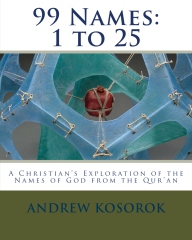Photos by Emily Ellis, Hawkinson Photography, and Wikimedia Commons
In concert with Dr. Sabiha Al Khemir’s profound Beauty and Belief exhibit at BYU, the Museum of Art has scheduled a series of workshops sampling aspects of Islamic culture. I was asked to present the first workshop in the series, and Friday we did “Why the Camel Smiles: Exploring the Tradition of the 99 Most Beautiful Names of God from the Qur’an.” My friend Emily came and took pictures.
Many faiths have traditions of Names for God, and share the belief that “Name” may not be the most appropriate word. “These are more attributes than Names,” a gentleman from Khadeeja Mosque explained. “God is infinite, and these are only approximations of His infinite Divine Attributes.” Although he was speaking specifically of the Sunni tradition, his sentiments echo among many Divine Name traditions.
In Christianity, there is less of a specific tradition of a codified list of Divine Names, but Mary Fairchild cataloged over a hundred Names for God from the Bible here. One mystical tradition among the Abrahamic faiths is the tradition of the 72 Names of God from the Torah (link). “Of course, they’re not names like what we use to address each other,” a Rabbi friend told me, “but are more symbols of intent. Meditation on them allows you to draw closer in spirit to the Divine.” The mystical Names from the Torah are not meant to be pronounced aloud, and anyone can benefit from meditation on the images of the Names themselves.
One of my favorite examples of a Divine Name tradition is the subject of an Arthur C. Clarke short story, The Nine Billion Names of God, in which computer experts are called upon to catalog the Names of God so the universe can be complete. In the interests of time, I elected not to list them.
During the workshop, we visited about the process of learning of another faith through a tradition like the 99 Most Beautiful Names of God in Islam (in practice a parallel somewhat to observance of the Beatitudes for many Christians). The 99 Names traditions in Islam are an outgrowth of passages from the Qur’an and from inspired utterances of the Prophet Mohamed (known as Hadith Qudsi); Sufism.org have a good list with English translations and commentary from Rumi here, and Julie Hliboki reflects on the 99 Names as an interfaith vehicle for peace. We spoke about the use of geometry and color in Islamic art, and visited displays in the Beauty and Belief exhibit to see some examples.
Returning from the exhibit, we touched on some geometric constructions, and I invited the workshop participants to reflect on which Divine Name was most personally meaningful–and make an abstract design responding to this. Then we built mosaics with an eye to the tracery windows of Damascus.
People that attended the workshop had a chance to learn a bit more about Islam and Islamic art, and a tradition much more universal and personally applicable than expected. While respectfully exploring the faiths of our neighbors, many times we can find much to strengthen our own. I’m grateful to Emily for the pictures, and to the museum staff; they gathered all the supplies and did the dirty work mixing cement so we didn’t have to. The workshop was a lot of fun, and I’m looking forward to the rest in the series.
And why does the camel smile? Only he knows the hundredth Name.


I like the notion of the camel smiling because it’s a secret he owns. Great ending.
I went to the workshop and it was a lot of fun and a lot of good information. I can’t wait to get my stepping stone in a garden.